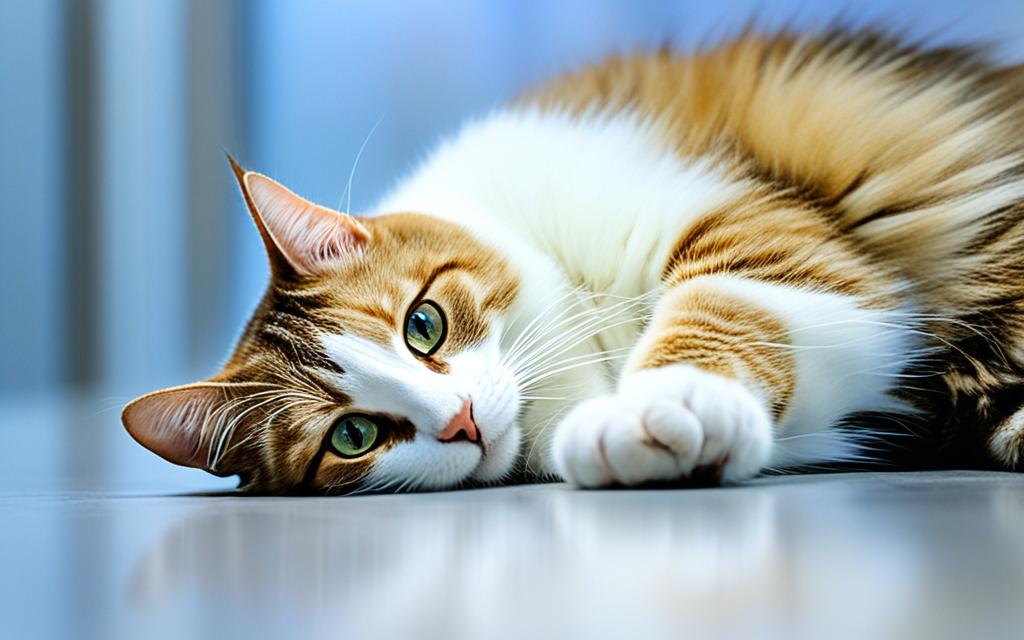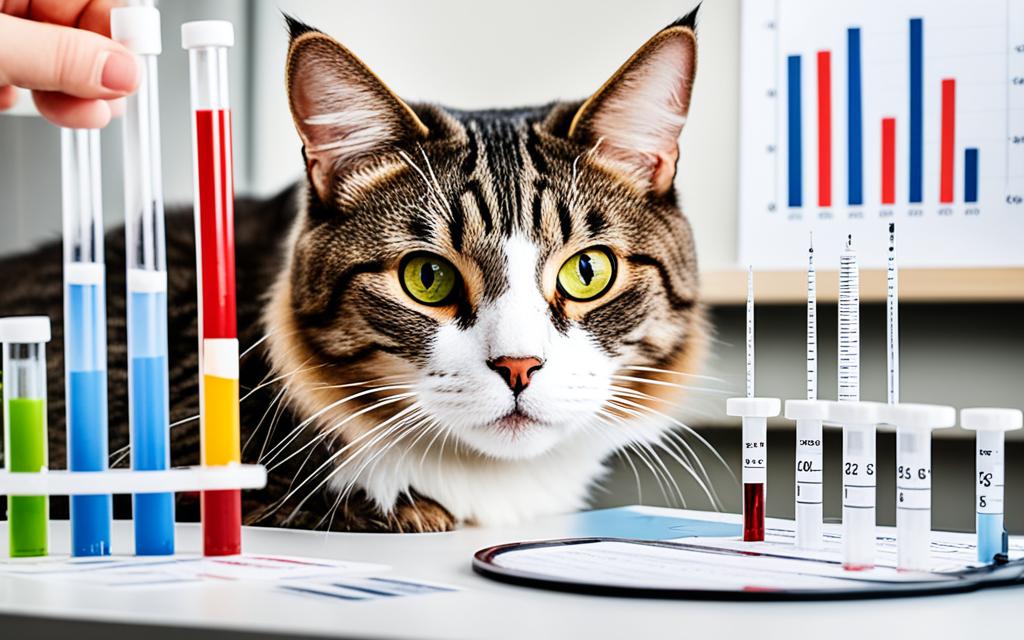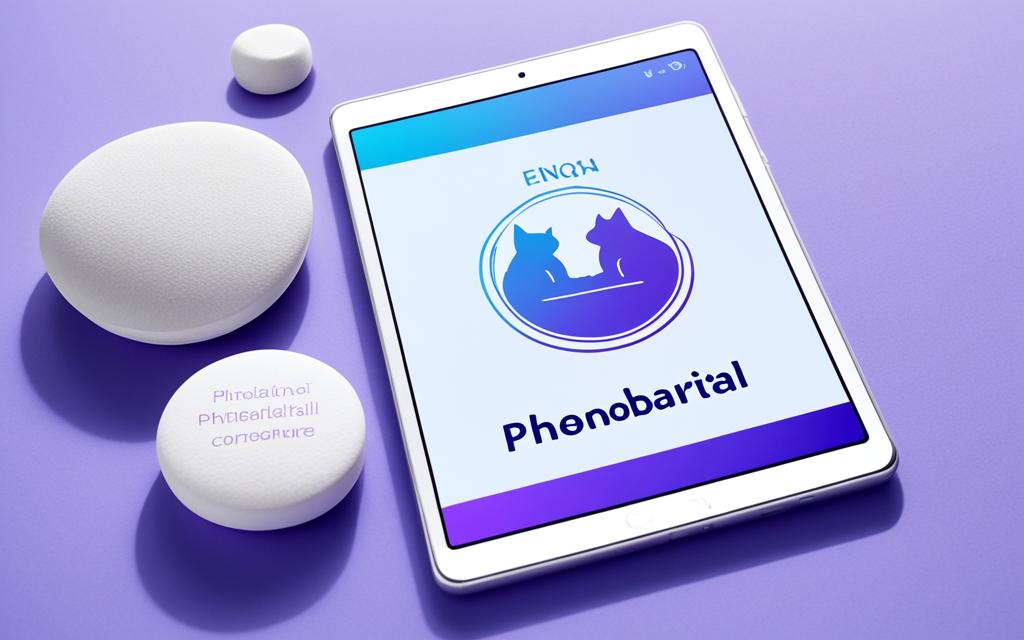Phenobarbital for cats Guide: Uses, Dosage, Side Effects
Phenobarbital is a well-known drug for cats. It’s used to treat seizures and epilepsy in cats1. This medicine is also given to dogs, horses, and other animals. It helps with various brain diseases and toxin diseases. Phenobarbital calms down the brain’s unusual activity, which causes seizures.
Despite not being fully approved by the FDA for animals, phenobarbital is very common in veterinary practice1. It can be used legally by vets for certain situations. Since it’s a controlled drug, following the proper laws when using it is a must1. In this guide, we will look into how to use phenobarbital for cats safely. You’ll learn about the right dose and possible bad effects. This information will help you take good care of your cat’s health.
Key Takeaways
- Phenobarbital helps manage seizures and epilepsy in cats, making it a popular choice in vet medicine.
- Vets prescribe it for different brain and toxin diseases that might affect various animals.
- Though not FDA approved, it’s still used legally in specific cases by vets.
- Phenobarbital is a controlled substance, so rules are in place for its use.
- Using this drug might cause some common side effects like tiredness, stomach issues, and liver problems in cats.
Table of Contents
What is Phenobarbital?
Phenobarbital is a medication called a barbiturate. It’s controlled by the DEA as a Schedule IV substance2. Both people and animals can use it. Vets can give this to cats and other pets if needed, even though it’s not directly approved for them.
Overview of Phenobarbital
This drug is very safe for cats. It helps with seizures and bad behaviors3. However, some cats might not react well to it at first3. Vets usually start cats on a small dose. Then, they increase it slowly to see what works best for each cat3.
Cats should have it twice a day. The usual start is half a 1/4 grain tablet each time3. But, your vet might want to give more later if needed for control3.
Medication Type and Forms
Phenobarbital comes in tablets, liquid, and shots for animals2. Tablets can be 15 to 100mg. The liquid usually is 20mg/5ml (4mg/ml)4. Your cat’s liver gets better at using the drug after about a week3. At first, cats might sleep more and seem tired. But, this often gets better as their body gets used to the drug3.
Brand and Common Names
It’s known by a few names. You might hear it called Luminal, Solfoton, or by the names phenobarbital and phenobarbitone2.
Since it’s a strong drug, vets and owners should be careful with it. Knowing about the drug’s types, names, and how to use it right is important. This helps make sure cats get the help they need safely, especially for seizures or other brain problems243.
About Phenobarbital for Cats
Understanding Seizures in Cats
Seizures in cats have various causes. These can include brain tumors, issues in the brain’s tissues, and certain diseases5. Other reasons are toxins, or low blood sugar. There’s also a special kind of epilepsy where doctors can’t find a clear reason5.
How Phenobarbital Works for Seizures
Phenobarbital’s a type of medicine called a barbiturate. It works by making the brain’s activity slower, which can prevent seizures from happening as often6. This happens because phenobarbital stops the brain from being too active, which can cause seizures6.
For cats, phenobarbital comes in different tablet sizes. These include 15 mg to 90 mg. Most cats take it 2 times a day6.
| Metric | Value |
|---|---|
| Mean serum concentration of phenobarbital at study completion | 5.57 mg/mL7 |
| Median serum concentration of phenobarbital at study completion | 4.08 mg/mL7 |
| Mean peak concentration of phenobarbital | 5.94 mg/mL7 |
| Mean time to peak concentration of phenobarbital | 13.3 days7 |
| Potency of transdermal phenobarbital gel | 62.98% to 82.02%7 |
| Seizures in cats evaluated at a veterinary hospital over a 5-year period | 2.1%7 |
| Recommended starting dose of phenobarbital for cats | 1.5-2.5 mg/kg bodyweight orally every 12 hours7 |
| Serum phenobarbital concentration range for seizure control in cats | 15-45 mg/mL7 |
| Compliance issues with oral medications in cats | 21.5% of the time medication was administered7 |

Doctors need to check the medicine’s level in the blood. They do this first after two weeks of treatment, then again at six weeks. After that, tests should be every six months or if the dose changes6.
For dogs, liver damage is a big worry with phenobarbital. But this is not usually a problem for cats6. Still, serious liver issues might happen with long term use, especially at high doses6.
It’s very important not to miss any doses of the medicine. Not taking it can bring seizures back6. If the seizures stop, you might think about stopping phenobarbital. But don’t stop it suddenly to avoid bad seizures6.
Too much phenobarbital in the blood can harm the liver. If the blood level is too high, another medicine might be added. This is to lower the dose and still control seizures6.
“Phenobarbital can reduce seizure activity with efficacy up to 93% in cats with Feline Idiopathic Epilepsy.”5
If your cat has FEPSO, starting phenobarbital early and using it strongly can control the seizures. This might even lead to a point where the cat doesn’t have seizures anymore5.
Benefits of Phenobarbital for Cats
Phenobarbital is a top choice for managing seizures in cats8. It’s known to work well. This makes it the first option for many vets. And it’s affordable, making it a great choice for long-term use8.
In a hospital study, seizures affected 0.5%-3.5% of cats8. When cats had ongoing seizures, about a fifth to over half were found to have epilepsy8. Research proves phenobarbital is effective for most cats with seizures8.
Studies show phenobarbital is safe for cats8. It’s a trusted option for vets. The low price also makes it a smart choice for managing seizures long-term8.
While some other drugs have been looked at, they aren’t as supported as phenobarbital8. Phenobarbital offers the right mix of help and affordability. It’s the go-to for many dealing with cat seizures8.
To wrap it up, phenobarbital’s known for effectively treating seizures in cats. Its cost-effective quality is a big plus. Choosing it gives both vets and pet owners peace of mind8.
Phenobarbital for cats Dosage
Phenobarbital is a DEA Schedule IV controlled substance9. Its prescription and use are closely watched. Vets decide the right dosage for each cat. They consider the cat’s weight, the type and number of seizures, and how the cat responds to the medication10.
Since phenobarbital isn’t FDA-approved for pets, vets use it in an “extra-label” way. This means they must have a strong relationship with the pet and its owner.
Safe Dosing Guidelines
Phenobarbital tablets for cats come in strengths of 15 mg to 100 mg9. The starting dose is usually 1–3 milligrams per kilogram of the cat’s weight. This equals 7.5 to 15 milligrams every 12 hours for the cat10. Vets might change the dose to get the best results and reduce side effects.
Monitoring Blood Levels
Vets often check the blood levels of phenobarbital in cats with a simple blood test9. This ensures the medicine is working well and that the cat is not having too many side effects. If needed, the vet will adjust the dose to keep the seizures under control.
Your cat should have a blood test two weeks after starting phenobarbital. Then, tests should be done every 6 months9. Sometimes, more testing is needed if the dosage changes or the cat starts having more seizures. Occasionally, the drug might make the liver enzymes go up, so the vet will keep a watch on the liver health of your cat9.

“Roughly 75% of a Phenobarbital dose is removed from the body by the liver for processing, and liver toxicity linked to Phenobarbital usage is associated with blood levels of 35 ug/ml or higher9. The liver may experience scarring due to chronic Phenobarbital exposure, more often observed in dogs than cats.”9
Side Effects of Phenobarbital for Cats
Phenobarbital is often prescribed to cats for seizures. But, it can cause side effects owners should know about11. These include tiredness, trouble moving, wanting more food and water, and peeing a lot more11. Some cats might scratch their faces more as well11.
In rare cases, cats might face bigger issues like problems with their immune systems, low white blood cells or platelets, and liver problems11. It’s really important to check your cat’s blood regularly to catch any problems early11.
Precautions and Interactions
If your cat has liver, kidney, heart, or lung problems, or is dehydrated or low in red blood cells, be careful with phenobarbital11. It can also mix badly with some other medications, like asthma drugs, blood thinners, allergy meds, and drugs for high blood pressure11. Make sure your vet knows about all the medicines and supplements your cat takes to avoid dangerous mix-ups11.
If your cat gets too much phenobarbital, it’s a big problem that needs a vet’s help right away11. Also, missing a dose might make your cat have a seizure, so sticking to the right schedule is key11.
“Phenobarbital is a controlled drug requiring a new prescription every 6 months.”11
So, phenobarbital can help with seizures in cats. But, owners must know the side effects and how to be careful. Check with your vet often. And watch how your cat responds to the medicine closely1112.
Administering Phenobarbital to Cats
Phenobarbital, the oldest anti-seizure medication discovered in 1912, is widely used for seizures in cats13. Seizures are a top reason why cats visit neurologists13. There are key steps to follow when giving phenobarbital to a cat.
Dosage Chart and Frequency
Every cat is unique, so the vet will set the right dose of phenobarbital. This is based on the cat’s size and how it reacts to the drug. Pets can take phenobarbital with or without food. But, giving it with food might prevent stomach issues.
| Cat Weight | Phenobarbital Dosage | Dosing Frequency |
|---|---|---|
| 5 lbs (2.3 kg) | 18-36 mg | Every 12 hours |
| 10 lbs (4.5 kg) | 36-72 mg | Every 12 hours |
| 15 lbs (6.8 kg) | 54-108 mg | Every 12 hours |
Different studies show that phenobarbital works well for cats when fighting seizures14. It is easily absorbed by the body when taken by mouth. Plus, after taking it by mouth, the drug remains effective for a long time14.
Missed Dose Guidelines
If a dose is missed, try to give it as soon as you remember. But, if it’s close to the time of the next dose, just go ahead with the next one. Never give a double dose. This might harm your cat.
Always listen to your vet when giving phenobarbital to your cat15. While applying it on the skin has been tested, it’s hard to get the drug level just right in the blood15. There might be mild side effects like skin redness or irritation from skin use15.
“Phenobarbital is usually the first choice of anti-seizure medication for cats due to its effectiveness.”13
Potential Side Effects and Precautions
When you give phenobarbital to cats, be careful. This is true for cats that are having kittens or already nursing. Why? Because phenobarbital goes through the placenta and into the milk16. This means it might not be safe for the baby kittens. A vet will think a lot before they give this medicine to such cats.
Pregnant and Lactating Cats
If a cat is pregnant or nursing, extra care is needed with phenobarbital. It goes through mom’s body to the baby kittens. This could affect the baby’s health and growth16. So, vets are very cautious when choosing this medication for these cats.
Adverse Reactions and Overdose
Too much phenobarbital can cause big problems, even death. Watch out for signs like sleepiness, coordination problems, low blood pressure, a slow heart rate, and hard breathing17. If you think your cat took too much, get them to a vet right away. Also, alert your vet if your cat seems very tired or has other strange symptoms regarding this medicine17.
Some cats might get used to phenobarbital or even depend on it. This is more likely if they take a lot of it for a long time17. If the cat needs to stop taking it, they could show strong withdrawal signs. It’s crucial their vet helps manage this process closely.
Be very careful with phenobarbital around pregnant or nursing cats. Overdosing or reacting badly to this medicine could be very dangerous. If you see something wrong, don’t wait. Get your cat to the vet right away. Only give this medicine under very careful watch and with a plan to stop it slowly, as a vet directs161718.
Comparing Phenobarbital to Other Anticonvulsants
Phenobarbital is a common anticonvulsant for cats, but there are more options. Drugs like zonisamide and potassium bromide may work differently and have different side effects19.
When vets choose a seizure medicine for cats, they look at how well it works, the cost, and how the cat reacts. This choice really affects how well the cat’s seizures can be controlled19.
A study by Finnerty et al. (2014) checked on the right levels of phenobarbital for seizures in 30 cats between 2004-201319. Another study by Marsch et al. (2021) looked at how often and what side effects cats get from phenobarbital19.
Other research, like the one by Charalambous et al. (2018), looked at how safe and effective these drugs are for cat epilepsy19. A trial by Heller et al. (2019) compared putting phenobarbital on the skin with giving it by mouth19.
Another big part of choosing the right medicine is if the cat owners can give it as needed. Wareham et al. (2019) highlighted this in their study19. Research by Cochrane et al. (1990) also gave insights on phenobarbital levels in cats with different ways of giving the drug19.
Choosing the best anticonvulsant for a cat is a big decision. It involves looking at lots of research and thinking about the cat’s individual needs. Vets make choices that help their patients the most by weighing the medicine’s effect, cost, and side effects19.
| Medication | Mechanism of Action | Effectiveness | Cost | Potential Side Effects |
|---|---|---|---|---|
| Phenobarbital | Enhances GABA-mediated inhibition | 85% seizure control20 | Relatively low cost | Sedation, liver toxicity, behavior changes |
| Zonisamide | Blocks sodium and calcium channels, enhances GABA | Comparable to phenobarbital | Moderate cost | Sedation, anorexia, gastrointestinal issues |
| Potassium Bromide | Inhibits neuronal excitability | 65% seizure control20 | Low cost | Sedation, polydipsia, polyuria |
Vets need to keep learning about new cat seizure treatments. They choose the best plan for each cat, so they live better with seizures19.
“Effective management of feline seizures requires a comprehensive understanding of the available anticonvulsant options and their comparative benefits and drawbacks.”19
Conclusion
Phenobarbital is a top choice for treating seizures and epilepsy in cats. It works for up to 93% of cats. This is if the right level, 15 to 45 μg/ml, is in their blood. However, giving it to cats is hard for about 18% of owners21.
There’s now a way to give phenobarbital that’s easier for cat owners. It’s through the skin, not the mouth. About 67% of owners prefer this method2122. But, it does need more checking to make sure it’s working right, no matter how it’s given22.
Phenobarbital is still the go-to treatment for cat seizures and epilepsy. It’s safe and doesn’t cost much19. By keeping an eye on it and adjusting as needed, it usually keeps seizures at bay. This helps cats lead better lives and brings comfort to their owners.
FAQ
What is phenobarbital and how is it used for cats?
What forms of phenobarbital are available for veterinary use?
What are the brand and common names for phenobarbital?
How does phenobarbital work to treat seizures in cats?
Why is phenobarbital considered an effective and preferred treatment for feline seizures?
How is the dosage of phenobarbital determined for cats?
Why is blood level monitoring important for cats on phenobarbital?
What are the most common side effects of phenobarbital in cats?
What precautions should be taken when using phenobarbital in cats?
How should phenobarbital be administered to cats?
What should be done if a dose of phenobarbital is missed?
What are the considerations for using phenobarbital in pregnant and lactating cats?
What are the signs of phenobarbital overdose in cats?
Are there other anticonvulsant options besides phenobarbital for cats?
Source Links
- Phenobarbital for Dogs and Cats
- Phenobarbital | VCA Animal Hospitals
- Phenobarbital in Cats
- Phenobarbital for Cats: Overview, Dosage & Side Effects – Cats.com
- Feline Epilepsy – NDSR
- Phenobarbital
- Evaluation of Transdermal Administration of Phenobarbital in Healthy Cats
- Systematic review of antiepileptic drugs’ safety and effectiveness in feline epilepsy
- Mar Vista Animal Medical Center
- Phenobarbital in Vet Medicine – Facts and Information | PetCoach
- Phenobarbital | Texas West Animal Health
- Microsoft Word – Phenobarbital
- A Better Life for Bruce
- Pharmacokinetics of phenobarbital in the cat following intravenous and oral administration.
- Testing Transdermal Phenobarbital in Cats
- Phenobarbital Oral: Uses, Side Effects, Interactions, Pictures, Warnings & Dosing – WebMD
- Phenobarbital (Phenobarbital): Side Effects, Uses, Dosage, Interactions, Warnings
- What is Phenobarbital? – NDSR
- Once-a-day oral treatment with phenobarbital in cats with presumptive idiopathic epilepsy
- Controlling primary epilepsy (Proceedings)
- Prospective crossover clinical trial comparing transdermal with oral phenobarbital administration in epileptic cats
- Comparing transdermal with oral phenobarbital administration in epileptic cats – EveryCat Health Foundation







